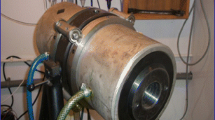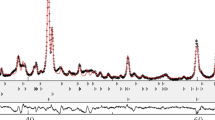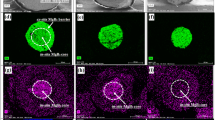Abstract
Ex situ MgB2 is usually considered as with lower critical current density (Jc) compared to the in situ one due to much worse inter-granular connectivity. In this work, we reported the fabrication of ex situ MgB2 superconducting tape without dopants using Monel as sheath materials and Nb as the barrier, which has an excellent Jc of 705 A/mm2 at 4.2 K under 4 T, almost as same as the in situ MgB2 wires. Massive and high-quality precursor powders with small grain sizes and quite low oxygen content were sintered at relatively low temperature and short time, 580 ∘C for 3 h. The effects of heat-treatment conditions and tape thickness on the microstructure and Jc of ex situ MgB2 tapes were discussed. The results suggested that the improvement of grains-connectivity was responsible to the excellent Jc properties of ex situ MgB2 tape.
Similar content being viewed by others
Avoid common mistakes on your manuscript.
1 Introduction
MgB2 superconductor (Tc = 39 K) has quite low raw cost, easy fabrication, and high current-carrying ability. It is very attractive to the superconducting magnet application in the field of helium-free magnetic resonance imaging (MRI), MW-grade wind turbine, and liquid helium (LHe) or liquid H2-cooling DC superconducting cables for high-energy particle (HEP) accelerator and magnetic confinement fusion reactor (CFETR) [1].
As it is well known, practical MgB2 superconducting wires and tapes are made by the in situ and ex situ powder-in tube (PIT) ways. Due to well grains connectivity, the in situ MgB2 wire normally has much better critical current density (Jc) than the ex situ one, which is always thought to be favorable due to their engineering application. But in fact, the in situ method is against the processing of several kilometer-length MgB2 superconducting wires because of the remarkable difference between the particle sizes of Mg and Boron powders. In contrast, by utilizing very fine and uniform MgB2 precursor powders, combing with high strength and easily deformed sheath materials, like Ni and Monel alloy, the drawing process of kilometer-grade ex situ MgB2 strand is much easier. But unfortunately, it is well known that now the application of ex situ MgB2 wire and tape is still limited by their worse grains connectivity, which results in their very poor in-field critical current density (Jc) performance [2, 3].
In order to improve the grains-connectivity of ex situ MgB2 wire and tape, many efforts have been performed, such as reducing MgO impurities in grains-boundary, enhancing their grains-coupling by high-temperature post-annealing [2,3,4]. Nakane et al. reported the improvement of the grains-connectivity and Jc properties of ex situ tape by using the precursor powders obtained from the in situ tapes [5]. By this method, they got the ex situ MgB2 tapes samples with very excellent in-field Jc properties. This approach, however, is only useful to make a very small amount of precursor powders in the laboratory scale. It is not enough for the production of engineering long wires. Therefore, the preparation of high-quality and mass precursor powders is significant to the large-scale application of ex situ MgB2 superconducting wires and tapes.
In this work, we report the preparation process of mass and high-quality MgB2 precursor powders as well as MgB2 tapes with very high critical current density. By using these powders, high critical current density ex situ MgB2 tapes have been made. The effects of the tape thickness and post annealing conditions on Jc of MgB2 superconducting tapes are also discussed.
2 Experimental Details
In order to prepare MgB2 precursor powders, Mg (325 mesh, 99% purity) and B (about 250 nm, 97 ∼ 99% purity, PAVEZYUM) powders were mixed with the atomic ratio of 1:2, milled for 1 h; then, these mixtures were filled into an Al2O3 tube with diameter of 25 mm. After the two ends of the tube are sealed by using Nb foil (Fig. 1), the sealed Al2O3 tube were put into the furnace and sintered at 580 ∘C for 3 h under a flowing Ar atmosphere. By the above process, bulk MgB2 superconductors have been obtained as shown in Fig. 1. Small amounts of white MgO impurities around bulk MgB2 were visible. After removing these MgO, the MgB2 bulks were crushed and ground into fine MgB2 powders in the glove box. In this way, mass precursor powders with high quality could be easily obtained. Then, these MgB2 powders were filled into Nb barrier tube with Monel sheath under Ar atmosphere. After that, the Monel/Nb/MgB2 composites were drawn up to a diameter of 2.0 mm, and then rolled into the tapes with different thickness, as shown in Fig. 2.
For the sheath material of ex situ MgB2 wires and tapes, many groups use the Ni matrix without any barrier layer, such as Columbus Company. Benefit of the high strength of Ni tube, Ni matrix MgB2 wires and tapes have very well drawing properties, and consequently, the Ni/MgB2 can have much large cold-deformation ratio as well as the tube with a little large diameter could be used. But the disadvantages of Ni matrix MgB2 are that the Ni is ferromagnetic material, which is not favorable to the design of superconducting magnet, and also, the Ni will react with MgB2 during the annealing process [6]. Therefore, in the work, we used Monel as sheath materials and Nb as the barrier. At last, the final heat treatment (HT) for these tapes was used to enhance the grains-connectivity of MgB2 superconductor. For the final heat-treatment of ex situ MgB2 tapes, there are some different opinions. Nakane et al. used a quite low temperature treatment at about 600 ∘C for 1 h [5], but the others use a sintering temperature up to 900 ∼ 920 ∘C for quite short time [7]. Therefore, in this work, we used various heat-treatment conditions from 600 to 900 ∘C with different duration time. The effects of final HT conditions on superconducting properties of MgB2 tapes will be discussed. Two HT conditions were used in this work. One is furnace heating and cooling (FHC) with slow heating rate of 5 ∘C/min and cooling with furnace, and the others was fast heating and air cooling (FHAC) with fast heating rate of about 1000 ∘C/min and cooling in the air.
The crystal structure of MgB2 powders were analyzed by x-ray diffraction (XRD, Philips X’Pert MRD) using Cu K-radiation. The microstructure of MgB2 bulks and their powders were investigated by field-emission scanning electron microscopy (JEOL, JSM6501). The particle size of MgB2 powder was measured by the laser particle diameter analyzer (LA-350, Horiba). The magnetization as a function of temperature (M − T) under an applied field of 20 Oe and a temperature range of 10 ∼ 45 K with a zero-field cooling (ZFC) process were measured by using the magnetic properties measurement system (MPMS, Quantum Design). Transport critical current properties of MgB2 superconducting tapes samples were detected by using the standard four-terminal method under applied field from 0 to 6 T. The definition criterion of Ic was 1 μ V/cm.
3 Results and Discussion
Figure 3a shows the XRD pattern of MgB2 powders prepared by grinding the MgB2 bulk, which was sintered at quite a low temperature, at 580 ∘C for 3 h. Many groups have verified that the solid-state reaction of Mg and B started about 550 ∘C [8]. Our previous results presented that for undoped MgB2 superconductor, the 580 ∘C for 3 h was an optimal heat treatment condition for obtaining very well critical current properties [9], due to the refined grains size and consequently excellent flux-pinning properties. As shown in Fig. 2a, the sample has a main MgB2 phase as well as negligible Mg and MgO impurities. By the refined calculation, the content of Mg is about 1.3% and MgO is below 0.2%, meaning that the MgO impurity has been strictly under control in this work. In contrast, for the normal solid-state MgB2 bulks, the content of MgO is often up to 3–5% [8, 10].
Figure 3b presents the distribution of MgB2 particle size after grinding. There are three peaks for these MgB2 powders. For most of the powders, the average grains size is about 150 nm, meaning that precursor powders with smaller grain size can be obtained by relatively low-temperature and short-time sintering. Furthermore, such small MgB2 particles size almost compares to the in situ MgB2 superconducting wire and tape with optimal flux pinning and Jc properties [11, 12]. It is worthy to point out that the fine MgB2 precursor powders are very significant to the industrial production of kilometer MgB2 long wires and tapes, as the MgB2 powders are actually hard to be deformed during the wire drawing process.
The critical current properties at 4.2 K under applied magnetic field of 4 and 6 T for ex situ MgB2 tapes with different thickness were shown in Fig. 4a, which are heat-treated at 600 ∘C for 1 h using FHAC condition. The critical current density, Jc, increases with the decrease of tape thickness, shown in Fig. 4b. The higher Jc for the tape with smaller thickness could be explained by the fact that the density of superconducting core enhances with reducing the tape thickness, as all the tapes were rolled from the same-sized round wires, as well as the grain-connectivity of MgB2 superconductor is improved. It is worth to note that the Jc as function of the tape thickness curves both at 4 and 6 T are almost linear improvements with the decrease of tape thickness, which furthermore certifies that theJc of ex situ MgB2 tapes is closely related with the density of superconducting core, as well as the grains-connectivity.
Figure 5 shows transportJc at 4.2 K under different applied magnetic fields for ex situ MgB2 tapes treated at FHAC and FHC conditions with different thickness. For the thick tapes (thickness ≥ 0.52 mm), the Jc depending on the applied magnetic field are almost the same for FHC and FHAC tapes. For the thinnest tape with 0.46-mm thickness, however, Jc for FHC tapes is higher than that for FHAC tape. This means that the heat treatment conditions of FHC and FHAC only affect the critical current when the tape thickness is less than a certain value, as well as the core density. For the 0.46-mm tape, the FAC sample has much better Jc than the FHAC, which may be attributed that the FAC sample have much longer heating and cooling duration time, and consequently, it has much better grains-coupling. Therefore, it can be concluded that except the core density of superconductor, for the ex situ MgB2 tape, the heat treatment conditions are another important factor that effects their Jc properties under the magnetic field.
Figure 6a, b show in-field Jc comparison for the ex situ FHAC 900 ∘C/20-min tape and the in situ MgB2 wires. It can be seen that the Jc values at 4.2 K under 4 and 6 T of ex situ FHAC 900 ∘C/20-min tape reach 705 and 176 A/mm2, respectively; and are almost as same as the in situ Cu matrix MgB2 wires with Nb as the barrier. The Jc properties of the in situ Cu matrix MgB2 superconducting wires were reported by our previous work [13]. These results imply that, in the ex situ FHAC sample, it has almost similar grains-connectivity and flux pinning properties with the in situ wire. Obviously, in this work, the achievement of both the excellent grains-connectivity and flux pinning at the ex situ tape is attributed by the high-quality precursor powder, as well as the high-temperature and short time sintering. Certainly, for these precursor powders, quite low oxygen and very small grains size play a decisive role. Figure 6c shows the temperature dependence curve of magnetic susceptibility for FHAC 900 ∘C/20-min tape under applied magnetic field of 20 Oe. It can be seen that its onset critical transition temperature, Tc, reaches 37.6 K and the width of superconducting transition, ΔTc, is only about 2.5 K, implying the superconductor with very well quality and without any dopant.
aV -I curves under different magnetic field for ex situ 0.46-mm-thickness MgB2 tape treated at different HT conditions. b The in-field Jc compare at 4.2 K between FHAC 900 ∘C/20-min tape and the in situ Cu/Nb barrier MgB2 wires [13]. c The temperature dependence curve of magnetic susceptibility for FHAC tape with a heat treatment of 900 ∘C for 20 min
For furthermore clearing, the effects of heat treatment conditions on the microstructure of ex situ MgB2 tape, Fig. 7 shows the SEM pictures of the FHC 600 ∘C/1-h and 900 ∘C/5-min samples with different magnification factor. By comparing Fig. 7a, b to d, e, it can be easily found that the tape with the 900 ∘C/5-min heat treatment has more dense structure than the 600 ∘C/1-h tape. The latter obviously presents many discrete and island structures and many grooves at grains boundary. The microstructure results of these two kinds of tapes are consistent with their transport critical current properties, as shown in Fig. 6a. In the meantime, the two tapes with 600 ∘C/1-h and 900 ∘C/5-min heat treatment have very similar grains size, as shown in Fig. 6c, f, although the 900 ∘C/5-min tape seems to be a little higher crystallization for MgB2 grains. This result suggests that by controlling the heating duration time, the grain growing rate of ex situ MgB2 tapes could be kept in a lower value.
4 Conclusions
In summary, we have prepared pure MgB2 tapes with very excellent in-field Jc properties using Monel as the sheath and Nb as the barrier by the ex situ way. At 4.2 K, the Jc under applied magnetic field of 4 and 6 T are up to 705 and 176 A/mm2, respectively, which are almost as same as the values for in situ MgB2 wire. The remarkable grains connectivity and very fine grains size, derived by the high-quality precursor powder and appropriate heat treatment condition, should be mainly responsible to its high in-field Jc properties. This work is significant to the practical engineering application of ex situ MgB2 superconducting wires and tapes.
References
Konstantopoulou, K., Ballarino, A., Gharib, A., Stimac, A., Gonzalez, M.G., Fontenla, A.T., Sugano, M.: Electro-mechanical characterization of MgB2 wires for the superconducting Link project at CERN. Supercond. Sci. Technol. 29, 084005 (2016)
Kario, A., Nast, R., Habler, W., Rodig, C., Mickel, C., Goldacker, W., Holzapfel, B., Schultz, L.: Critical current density enhancement in strongly reactive ex-situ MgB2 bulk and tapes prepared by high energy milling. Supercond. Sci. Technol. 24, 075011 (2011)
Tanaka, H., Yamamoto, A., Shimoyama, J., Ogino, H., Kishio, K.: Strongly connected ex-situ MgB2 polycrystalline bulks fabricated by solid-state self-sintering. Supercond. Sci. Technol. 25, 115022 (2012)
Fujii, H., Ozawa, K., Kitaguchi, H.: Improved critical current density in ex-situ processed carbon-substituted MgB2 tapes by Mg addition. Supercond. Sci. Technol. 25, 065008 (2012)
Nakane, T., Kitaguchi, H., Kumakura, H.: Improvement in the critical current density of ex-situ powder in tube processed MgB2 tapes by utilizing powder prepared from an in-situ processed tape. Appl. Phys. Lett. 88, 022513 (2006)
Varghese, N., Vinod, K., Kumar, R.G., Syamaprasad, U., Sundaresan, A.: Influence of reactivity of sheath materials with Mg/B on superconducting properties of MgB2. J. Appl. Phys. 102, 043914 (2007)
Malagoli, A., Braccini, V., Bernini, C., Romano, G., Vignolo, M., Putti, M., Ferdeghini, C.: Study of the MgB2 grain size role in ex-situ multifilamentary wires with thin filaments. Supercond. Sci. Technol. 23, 025032 (2010)
Takahashi, M., Kumakura, H.: The enhancement of critical current density of powder-in-tube processed MgB2 tapes by pre-heating of Mg and B mixed powder. Supercond. Sci. Technol. 26, 075007 (2013)
Pan, X.F., Matsumoto, A., Kumakura, H., Cheng, C.H., Zhao, Y.: Combined effect of upper critical field and flux pinning on enhancing critical current density of in-situ MgB2/Fe tapes with various carbon sources simultaneously doping. Appl. Phys. Express 5, 013102 (2012)
Jiang, J., Senkowicz, B.J., Larbalestier, D.C., Hellstrom, E.E.: Influence of boron powder purification on the connectivity of bulk MgB2. Supercond. Sci. Technol. 19, L33–L36 (2006)
Xu, X., Kim, J.H., Dou, S.X., Choi, S., Lee, J.H., Park, H.W., Rindfleish, M., Tomsic, M.: A correlation between transport current density and grain connectivity in MgB2/Fe wire made from ball-milled boron. J. Appl. Phys. 105, 103913 (2009)
Matsumoto, A., Kumakura, H., Kitaguchi, H., Hatakeyama, H.: Effect of impurity additions on the microstructures and superconducting properties of in situ-processed MgB2 tapes. Supercond. Sci. Technol. 17, S319–S323 (2004)
Pan, X.F., Yan, G., Wang, Q.Y., Cui, L.J., Li, C., Wang, D.Y., Liu, X.H., Feng, Y., Zhang, P.X.: Very large engineering critical current density properties in a (6 + 1)-structure MgB2 superconducting cable at 20K. IEEE Trans. Appl. Supercond. 27, 6201005 (2017)
Acknowledgements
This work was supported by the National Key Research and Development Plan (no. SQ2017YFE030073), the Program of International S&T Cooperation (grant no. 2013DFA51050), and the National Nature Science Foundation of China (grant nos. 51271155, 51377138, and 11405138).
Author information
Authors and Affiliations
Corresponding authors
Rights and permissions
About this article
Cite this article
Sun, X.G., Yang, X.S., Pan, X.F. et al. Ex Situ MgB2 Superconducting Tape with Very High Critical Current Density by Using Low-Temperature Sintering Precursor Powders. J Supercond Nov Magn 32, 1225–1230 (2019). https://doi.org/10.1007/s10948-018-4861-y
Received:
Accepted:
Published:
Issue Date:
DOI: https://doi.org/10.1007/s10948-018-4861-y











